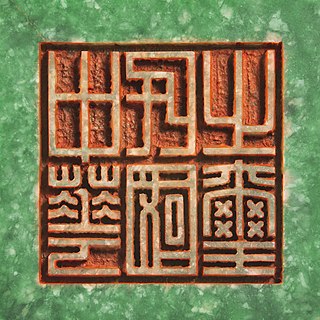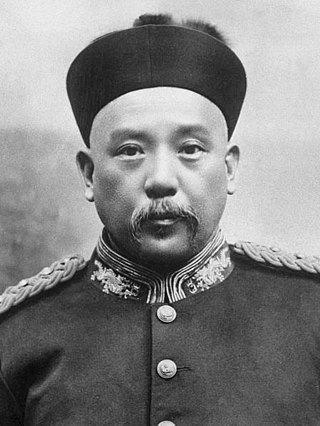Related Research Articles

Dai Jitao or Tai Chi-t'ao was a Chinese journalist, an early Kuomintang member, and the first head of the Examination Yuan of the Republic of China. He is often referred to as Dai Chuanxian or by his other courtesy name, Dai Xuantang.

The Ministries of Japan or Government Agencies of Japan are the most influential part of the executive branch of the Government of Japan. Each ministry is headed by a Minister of State appointed by the Prime Minister. In postwar politics, the posts of ministers have been given to senior legislators, mostly of the LDP. However, few ministers serve for more than one or two years to develop the necessary grasp of the organisation to become really influential. Thus, most of the power lies within the ministries, with the senior bureaucrats.

Dayuanshuai was a Chinese military rank, usually translated as grand marshal or generalissimo.

Yuexiu District is one of 11 urban districts of the prefecture-level city of Guangzhou, the capital of Guangdong Province, China, located west of the Tianhe District and east of the Liwan District. It is the commercial, political and cultural centre of Guangdong and noted for its high-quality education. The Guangdong provincial government and the Guangzhou city government are both located in the Yuexiu District. Established in 1960, the district absorbed the former Dongshan District in May 2005 along with several former subdistricts of the Baiyun and Tianhe district. Yuexiu District has 18 streets under its jurisdiction. The total area is 33.8 square kilometers. According to the seventh census data, as of 0:00 on November 1, 2020, the resident population of Yuexiu District was 1,038,643.

He Fenglin was a general in the Republic of China. He belonged to the Anhui clique and the Fengtian clique.
Japanese people in China are Japanese expatriates and emigrants and their descendants residing in Greater China. In October 2018, there were 171,763 Japanese nationals living in the People's Republic of China, and 24,280 Japanese nationals living in the Republic of China (Taiwan).

The 127th Combined Arms Brigade is the primary maneuver element of the 82nd Group Army in the Central Theater Command of the Chinese People's Liberation Army and is its sole infantry division as of present.

The Canton Merchants' Corps Uprising or Canton Merchants' Corps Incident was an armed conflict between the Canton Merchants' Volunteer Corps and the Nationalist army in Guangzhou, China, in late 1924. It ended in a decisive government victory.

Luo Xianxiang (1890–1968) was a World War II Chinese general who served in the army of Chen Jiongming. He was a soldier, and at times, a regional government official. He established anti-corruption policies and conducted administrative and education reforms.

The Japanese School of Guangzhou is a Japanese international school in Tianhe District, Guangzhou, Guangdong, China. It was established in April 1995. On June 13, 1995, the Ministry of Education of China approved the establishment of the school.

Lu Rongting, also spelled as Lu Yung-ting and Lu Jung-t'ing, was a late Qing/early Republican military and political leader from Wuming, Guangxi. Lu belonged to the Zhuang ethnic group.

The Government of the Republic of China was the government that led the Second Constitutional Protection Movement. The military junta was replaced by a presidential system.

Li Yuan was a politician of the Republic of China and later Manchukuo.

Dongnyeong Prefectures were administrative divisions of the Mongol-led Yuan dynasty of China located in the northwest Korean Peninsula between 1259 and 1290.

The National seals of the Republic of China or the National seals of Taiwan are the official seals of Taiwan. The Seal of Honour is used by the head of state in the conferring of honours.

The Nanking Provisional Government cabinet, also known as the Sun Yat-sen cabinet, was a temporary cabinet of the republican era of China. The first cabinet assembled following the formation of the Provisional Government on 1 January 1912, it was formed on 3 January 1912 and dissolved on 1 April the same year. It was the first and only cabinet led by Sun Yat-sen, the first provisional President of the Republic of China.

The Reorganisation loan affair was a series of political incidents in the Republic of China between March 1912 and 1913. It began when Yuan Shikai, the provisional President of the country, attempted to resolve financial difficulties in the Beiyang government by taking significant loans from the China Consortium of foreign banks without the approval of the National Assembly. The loan, amounting to £25 million, forced the Beiyang government to cede partial control of its national treasury to foreign ownership as leverage. Yuan's decision to obtain the loan generated controversy in China, especially within the National Assembly and the government, as the terms negotiated to obtain the loan were considered a national humiliation. Several cabinet members, including Premier Tang Shaoyi, resigned in protest against Yuan's decision. Along with other political incidents, notably the assassination of Song Jiaoren, the event caused a large-scale political crisis that lasted until 1914, provoking the Kuomintang to launch the Second Revolution in July 1913, which ended in failure.
Zhao Yong was a Chinese military general during the early Ming dynasty. He was a younger brother of Zhao Zhongzhong (趙仲中).
References
- ↑ Hu, Sheng (1991). From the Opium War to the May Fourth Movement. Foreign Languages Press. p. 655. ISBN 978-7-119-00008-4.
- ↑ Hummel, Arthur W. (2018-01-01). Eminent Chinese of the Qing Period: 1644-1911/2. Berkshire Publishing Group. p. 38. ISBN 978-1-61472-849-8.
This article needs additional or more specific categories .(January 2024) |